First of all, we welcome you to the PWHG Website! We hope you find the information helpful and informative!
The birth of PWHG revolves around 2 storms that struck the Texas Gulf Coast. One being a devastating hurricane (Hurricane Ike) and an unprecedented winter storm (Winter Storm Uri).
HURRICANE IKE STARTED IT ALL:
Hurricane Ike (2008): When Hurricane Ike hit in September of 2008, I lost power for over a week. Thankfully I had a typical “Big Box” portable generator. This was the first time I ever used a generator for emergency power. I discovered really quickly the challenges you face when using a portable generator in an emergency, which included: pulling out heavy refrigerators and freezers to directly connect extension cords that were spread all over my home; the challenge of getting gasoline locally during a widespread power outage; the challenge of refilling a hot generator with fuel (must be turned off and cool before safely refilling), etc. Thankfully, due to central A/C breakdown earlier that summer, I had purchased and installed a window unit A/C installed in my master bedroom. As the temperature was in the mid 90’s right after Hurricane Ike came through, I ran an extension cord from the portable generator to that A/C unit for sure! I was very grateful to have “some power” and a cool room during the power outage, but I also learned the 2 things I disliked most about having a portable generator:
- Gasoline Presents a Number of Challenges: First of all, to keep your gasoline generator ready to run for an emergency: a. I had to make sure I added fuel stabilizer to the gasoline wouldn’t go bad; b I had to drag the generator out of the garage, and start it EVERY MONTH! Why? I learned that if I didn’t do this religiously, the generator “gum up” and my generator wouldn’t start when I needed it; then, c: I had to purchase a handful of large gas cans that I would never use otherwise, and d. purchase large amounts of gasoline to have on hand as I awaited an oncoming storm; and lastly (and it gets worse), e. When the storm hit and caused regional and prolonged power outages, I struggled terribly to buy more gasoline as there was no electricity to run the gas pumps at the convenience stores and gas stations! So, I had to travel long distances and wait in line for gasoline to keep my generator running.
- Extension Cords and their Limitations: This was a royal pain! First: a. You need to purchase heavy gauge (and expensive) extension cords to run power from the generator to your appliances long distances throughout your home; then, b: As your generator is outside and your appliances are inside, you remove window screens and run extension cords through open windows, or under doors (which makes your home insecure and gives an opening for bugs to harass you all day long); then you had to, c. Wrestle with large appliances to get access to their power cords behind them: and d. You were limited as to what you could run by the number of extension cords and plugs. Frankly, I hated the mess, the cords, the open windows and doors, and most of all, the huge limitation of what things had power! Like one of the neighbors told me, “It’s nice to have a portable generator, but it’s basically useless!.”
So, I set out on a mission to fix the “Gasoline” and “Extension Cord” problems. First, I wanted to run my generator on natural gas as this fuel source is run underground, rarely goes out in storms, and is “always” available PLUS no need to refill gas cans!) Secondly, I wanted to find a way to legally and easily feed the generator power to all areas of my home. I had heard about people backfeeding power through their house through their 220V Dryer plug, the risk of “suicide cords” that people made up, the risk of electrocuting a lineman working to restore power. Bottom line, if not done correctly, it was dangerous, potentially deadly, and illegal!
WINTER STORM URI HITS TEXAS HARD – PWHG IS BORN
When I created this generator system prototype in 2009 after Hurricane Ike, I was proud to show off the system and felt it was a pretty clever approach to the main limitations of a standard portable generator. Since then, I have helped dozens of people pull a system like the one mine. However I never viewed this as a business to pursue.
Then, Winter Storm Uri hit Texas in Feb 2021, and caused widespread and prolonged power outages and countless hardships for residents. Thanks to some very supportive neighbors seeing this generator system in action, in combination with some well-timed social media posts, the system I developed in 2009 gained quite a bit of attention locally. The weekend following the storm, I had 32 people come by to see a demo of this concept. Many of the people I spoke to were elderly, single moms, and young families that did not have the financial resources to install a whole house generator by a “Generator Superstore” (that sells in our area for ~$14K (+ tax) PLUS $500 to $1000 per year annual maintenance which they are strongly compelled to purchase as well! Everyone loved my setup, but virtually everyone asked me to find or develop a portable generator that was able power at least one large air conditioning unit as well as a number of pool pumps. So, seeing the need and the interest, I developed specifications that I personally wanted in a generator like this, and they were:
- Generator must be portable
- Quality name brand engine
- Runs efficiently on Propane (LPG) and Natural Gas (NG)
- Produces “clean power” for sensitive electronics (ideally < 5% Total Harmonic Distortion)
- Electric start
- The “large” system to truly be a “whole house standby generator alternative” with the ability to power one Central A/C Unit (up to 5 Tons) and all other components in your home.
- Maintains a minimum of a 3-year warranty
A large portable generator prototype was built to these specifications to meet all of these requirements, and on May 23, 2021, I successfully tested out this generator system that ran my entire 4,000 sq. ft house with 3 Refrigerators, 1 large upright freezer, and had no problem running 1 large A/C (up to 5 tons)! In my case, when the system easily runs both Central A/C’s for me (4 Ton and 3 Ton Units) AND 50 Amps of pool pumps when I brought them on one at a time (not all at once). At that moment, PWHG was formed!
I want to thank everyone who have confidently supported this effort!
Best Regards,
Mark F. Kidder
Founder
Portable Whole House Generators (PWHG)



